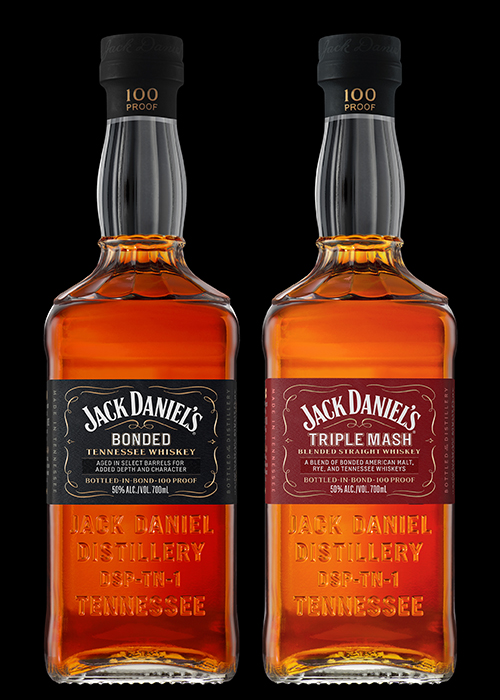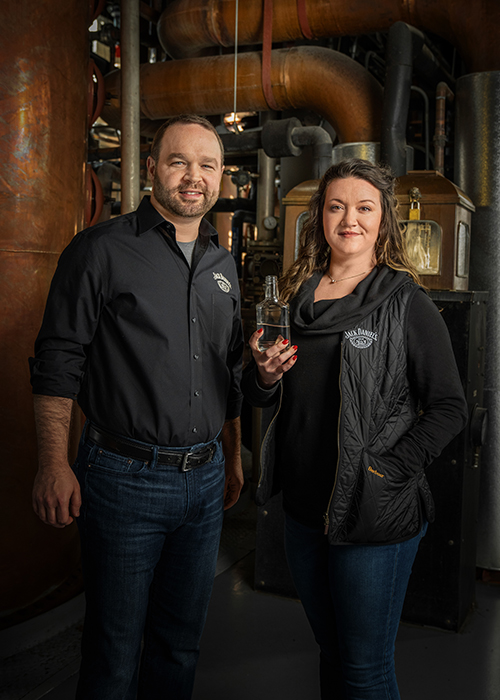For over 150 years, since its founding in 1866, Jack Daniel’s made a single recipe: Tennessee whiskey. Then in 2017, the distillery released its first rye. Now, the best-selling whiskey in America is stepping into yet another style — one that will surprise, and hopefully delight, craft spirits fans.
Jack Daniel’s is debuting a new line extension called the Bonded Series, starting with two releases. The first one is a bottled-in-bond Tennessee whiskey — effectively a higher-proof, more oak-forward version of the classic Old No. 7. (It’s also a different flavor profile from the bottled-in-bond Jack Daniel’s that came out a few years ago at travel retail.)
The second release features quite a different recipe. Jack Daniel’s Triple Mash is a blend of straight whiskeys: all distilled in-house, filtered through sugar maple charcoal, matured in new charred oak barrels, and — meeting the requirements of bottled-in-bond — made in a single season. The base of the blend is 60 percent Jack Daniel’s rye, layered with 20 percent Tennessee whiskey.
Don’t miss a drop!
Get the latest in beer, wine, and cocktail culture sent straight to your inbox.
But it’s the third whiskey that reveals a big secret the distillery has been sitting on. Making up 20 percent of the blend, the final whiskey in Triple Mash is distilled from 100 percent malted barley. Yes, Jack Daniel’s is making single malt whiskey, and Triple Mash offers the first taste.

The Jack Daniel’s Thumbprint
Single malt has actually been in the works for almost a decade at Jack Daniel’s. Master distiller Chris Fletcher confirms that the distillery has been laying it down since 2013, though the liquid in Triple Mash is younger than that — around five and a half years old. “We learned a lot from the early days,” he says, explaining that after a few trials with distillers’ malt, used in the production of the other whiskeys, the distilling team decided to switch to brewers’ malt.
“That gives you more plump, rich, higher-carbohydrate malt,” Fletcher says. “That kind of fatty, biscuity, toasted mouthfeel that you get with malt — we wanted to increase that” in the Triple Mash blend. Thus the malt’s contribution comes through in a mouth-filling texture and prominent cereal notes.
Jack Daniel’s also decided early on that its single malt would be matured in new charred oak barrels, just like a Tennessee whiskey or rye. “Our new make [Tennessee and rye] whiskey is really rich, really fruity. Right off the still there’s a lot of character,” Fletcher explains. “Working with 100 percent malt, we lost a lot of that. You get a little sweetness but you don’t get near the fruity aroma and character.”
Putting the malt in new charred oak barrels gives it a boost of flavor from the wood, and brings the profile more in line with the rest of the Jack Daniel’s portfolio. Along with other production details, like fermenting and distilling on the grain and using a column still, it sets the whiskey apart from most existing American single malts, which are typically pot-distilled without grain solids, and often matured in used barrels.
“The goal was to do it in a way that Jack Daniel would do it and that Jack would be proud of,” Fletcher says, describing it as putting a “thumbprint” on the American single malt style. “How we make whiskey — apply that process to that 100 percent malt spirit, knowing that it’s going to be different. We’re not going to recreate what they do in Scotland, and that wasn’t the goal.”
A Very Different Animal
But Jack Daniel’s also isn’t falling in line with prevailing trends in American single malt. Up to now, the budding style has been led by small-scale distillers like Westland, Balcones, and Stranahan’s, which fill just a few thousand barrels annually — an amount Jack could do in two or three days. The demand for American single malt simply doesn’t support more than that yet. But a spotlight from Lynchburg could result in a lot of newcomers exploring the style, with Jack Daniel’s as their entry point.
What that could mean for the category is an open question. The profile that Jack is making — which shares many parallels with straight bourbon and rye, given the production overlap — sits apart from most other American single malts. There should be room at the table for all comers, but it’s impossible to ignore the outsize influence that Jack Daniel’s — the largest whiskey distillery in America — would have, especially given the lower prices it can offer thanks to its economies of scale. And that’s before even considering the other major whiskey players, like the James B. Beam Distilling Co. and MGP that are currently making American single malt and will inevitably release it in the near future.
Whatever the future holds, Jack Daniel’s is all in. Fletcher says that pre-pandemic, single malt production at Jack Daniel’s had amounted to a few 1,000-barrel runs annually, and he plans to increase production as the category grows. Triple Mash includes single malt as one component of its blend, but Jack will release a standalone single malt, finished in sherry casks, later this year — and there’s more to come after that.
“The big thing for us is figuring out how do we continue to feel really confident about making malt whiskey here,” Fletcher says, calling it one of the most difficult things he’s done in his 20-year career. “It’s a very different animal.”



